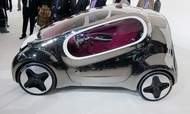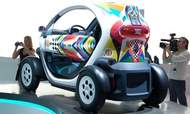Paris Auto Show: Electric Cars Create Buzz
It seems just about every carmaker at the Paris motor show had an electric car on the stand, and some had nothing but electric cars. The show floor was buzzing with them.
Big manufacturers showed models with production possibilities while whacky little companies you've never heard of promised to revolutionize transportation with EVs as eclectic and diverse as human imagination.
The one that got the de facto Best EV of Show was the Renault DeZir. With scissor doors and a low, swoopy shape, as Renault said, "DeZir stands out as an illustration of the brand's commitment to more emotional styling."
That might be an understatement.
Perhaps more exciting than the styling is the DeZir's connection to production vehicles. It uses a motor and a 24-kilowatt-hour lithium-ion battery similar to that found in the Nissan Leaf but tuned for greater performance. Zero to 60 mph comes up in five seconds and top speed is 112 mph. All of that with a range of 100 miles. While the body is Kevlar and the frame is tubular steel, it is similar to the body used in the Megane Trophy race car. Same with the double-wishbone suspension front and rear. Imagine a Tesla built by Nissan/Renault for a price well below that of the Tesla's six figures. EVs would suddenly become cool.
Far less sexy but also Leaf-related was the Nissan Townpod, a rounded-off, Leaf-sized design study in EV chic. With hinged rear doors and a disappearing rear seat, the Townpod is a little more versatile than the Leaf. It's just a concept for now, but maybe it hints at a small electric commercial vehicle in Nissan's future. That's just our speculation. A couple Nissan Leafs (Leaves?) were also on hand.
 The Kia Pop concept is far less practical, with side windows that look like designer salvage bits from a '60s space pod and proportions of something you'd see in a petri dish. The chrome exterior and the three purple seats also help set it apart. Its 18-kilowatt-hour lithium-polymer-gel battery makes 68 hp and zwips it to a top speed of 87 mph.
The Kia Pop concept is far less practical, with side windows that look like designer salvage bits from a '60s space pod and proportions of something you'd see in a petri dish. The chrome exterior and the three purple seats also help set it apart. Its 18-kilowatt-hour lithium-polymer-gel battery makes 68 hp and zwips it to a top speed of 87 mph. As striking as the Pop was, it actually had some competition at the Paris show from the similarly wacky Peugeot Bbl, a strikingly proportioned EV that debuted last year at Frankfurt.
Another earlier debut also shown was the Citroën Survolt, a 300-hp, 150-mph, two-seat carbon-fiber racer first shown at Geneva but which has since been finished and driven by some Euro press members (and not, unfortunately, by us).
Mercedes-Benz is leasing its A-class E-Cell to select customers in Europe. A 36-kilowatt-hour lithium-ion battery pack powers the 95-hp motor and takes the E-Cell to a top speed of 93 mph, enough to safely traverse das autobahnen. Range is 124 miles. No U.S. plans were announced.
Mercedes also unveiled a new version of its Smart Fortwo electric car, this one with solar roof panels that Benz claims extend useful range by 10 percent.
The EV most likely to populate European streets first was the Mitsubishi i-MiEV, offered not only by Mitsubishi but by partners Citroën and Peugeot. The tiny four-seater is perfect for Parisian commuters with a small turning radius, short overall length, a decent range of 50 to 70 miles and a relatively lightweight 16 kilowatt-hour battery pack for efficiency. Peugeot and Citroën finally got decent, pronounceable names for the car, too: Peugeot calls its i-MiEV the ion and Citroën calls its version the C-Zero.
Mitsubishi said it wants to sell the car in 16 countries priced between 30,000 and 35,000 euros, which is higher than the U.S. price of less than $30,000 before the massive government rebates. U.S. buyers get their i-MiEVs in about a year.
Volvo showed an electric C30, of which it will make about 250 for mostly European fleet use by this summer. A few will make it to U.S. fleets. In keeping with the company's safety image, Volvo did full crash tests on five electric C30s, which had to be reconfigured to fit underbody battery packs and to swap out the usual front-mounted internal-combustion engine. All C30 EVs meet European NCAP safety standards. The battery pack is 24 kilowatt-hours, which should give it a range of more than 100 miles. Considering how cold it gets in Sweden, Volvo addressed the climate problem by including a separate heater that runs on ethanol.
 Renault showed new and old versions of its ultra-stylish Twizy electric concepts.
Renault showed new and old versions of its ultra-stylish Twizy electric concepts.Saab showed an electric 9-3 wagon called the ePower.
Tesla was on hand with a pair of roadsters.
And there were electric scooters from Mini, Smart and Peugeot.
Venturi unveiled an open-topped "buggy" version of its 300-plus-hp carbon-fiber Fetish electric roadster supercar first seen in 2004. Venturi plans to announce details of its Columbus, Ohio, engineering and production facilities at the Detroit auto show. The company's goals include vehicles more affordable than the Fetish's 300,000 euro price. Also on display was a Venturi land-speed car that hit 286 mph at Bonneville.
Then there was Hall 3 of the Porte de Versailles, which was packed with many, many offbeat, sometimes quirky interpretations of what an electric vehicle could be. Funding? Production? Crash testing? There were too many cars and carmakers here to sort through all those details. But we had a look at several of them.
We liked the Lumeneo Smera, a four-wheeled enclosed tandem two-seater, the front half of which leaned into corners like a motorcycle. The company also had a four-seater enclosed EV called the Neoma.
Tazzari Electric had several uprightly styled two-seaters. Matra had a GEM-like four-seater. We loved the looks and practicality of the Mega Multitruck EV. Ligier had several small commuter cars for use en ville as well as a large (relatively large) people hauler.
So whatever the future holds, at least part of it will be electric. We hope the fun and stylish cars we saw at Paris make it to our shores someday.
Content provided by AutoWeek.
Get more Car News from AutoWeek.
Get the latest Car Reviews from AutoWeek.

I wanna go to an auto show D:
ReplyDeleteI want that Citroën Survolt
ReplyDeletethat renate concept is sexy :p
ReplyDeletei need ad clicks sir
ReplyDeleteCool electric cars indeed.
ReplyDelete